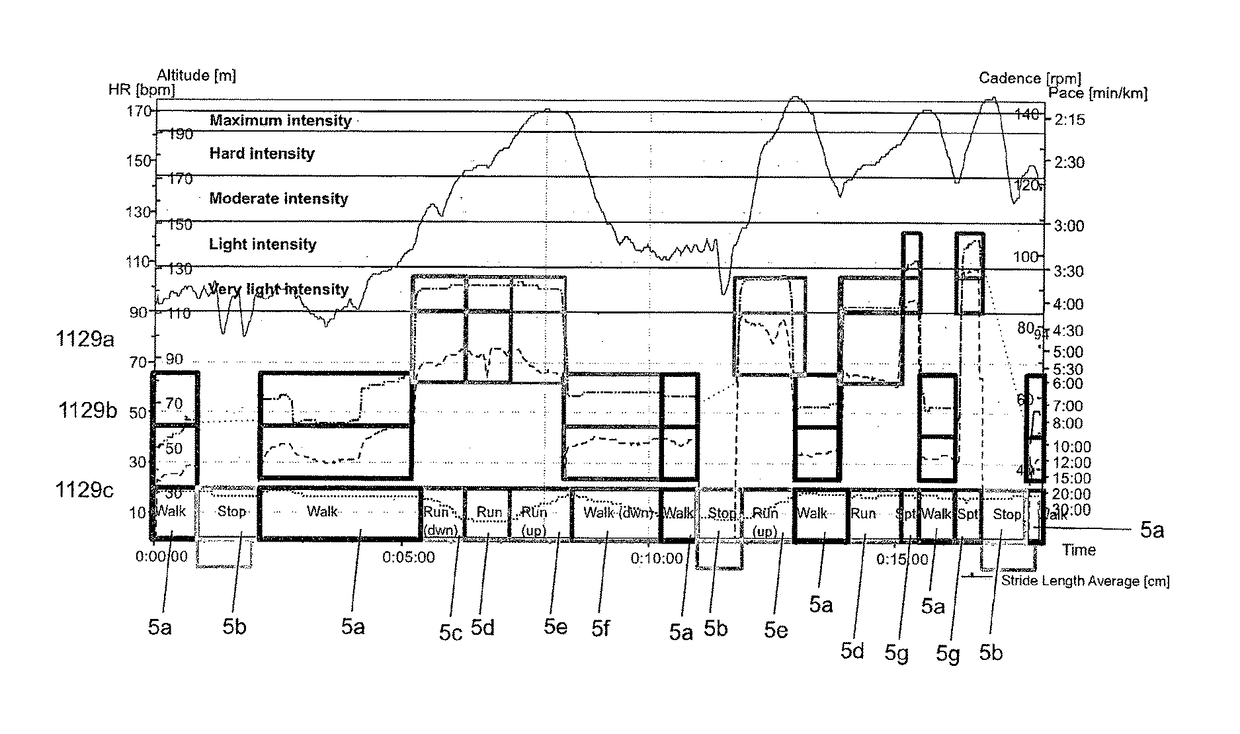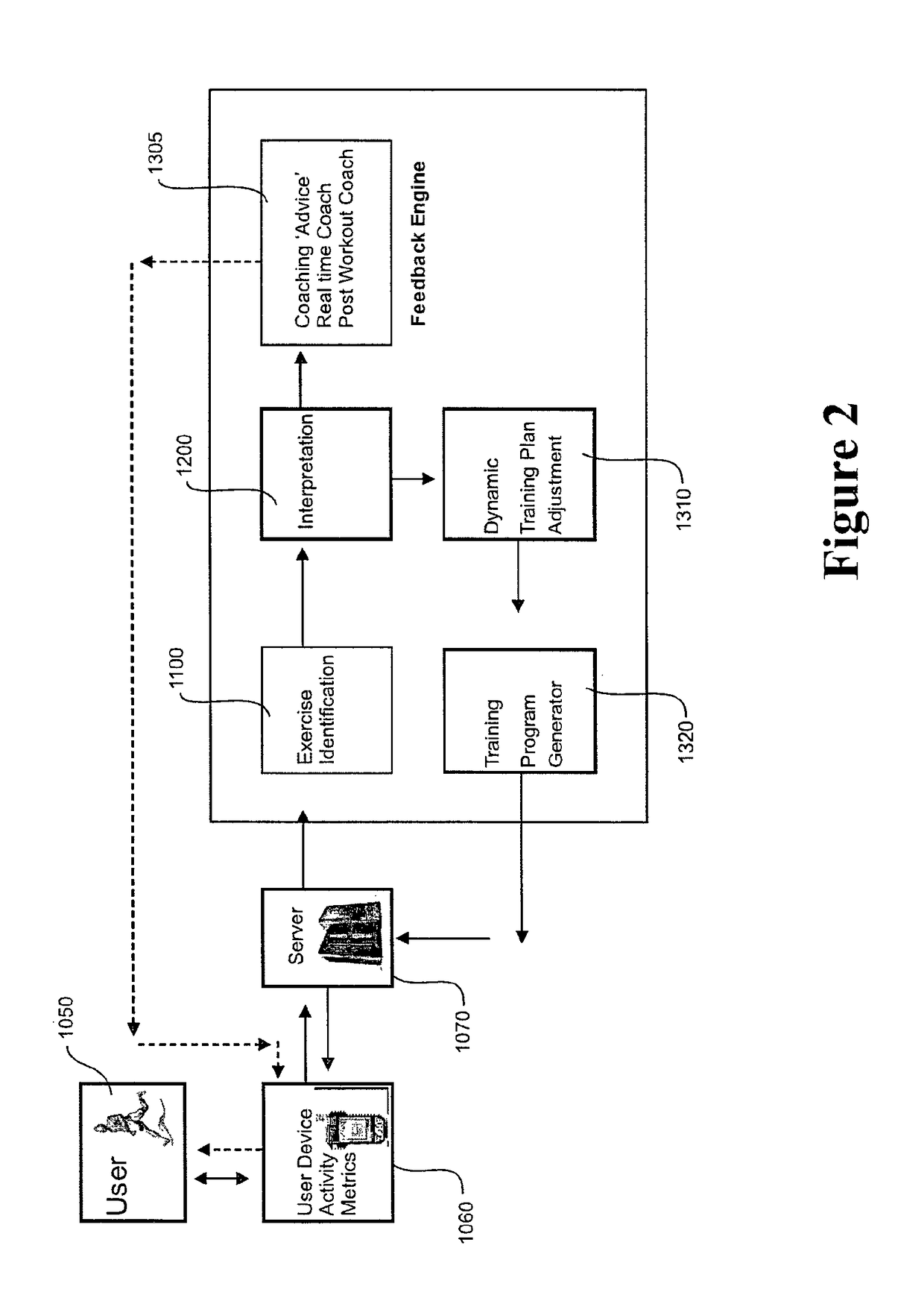Automated physical activity classification
a technology of automatic classification and physical activity, applied in the field of exercise and/or activity monitoring, can solve the problems of poor user experience, large variability and error within the data obtained, and the user is difficult to effectively interpret the representation of quality or us
- Summary
- Abstract
- Description
- Claims
- Application Information
AI Technical Summary
Benefits of technology
Problems solved by technology
Method used
Image
Examples
example two
[0112]FIG. 9 shows another example of application of the classification system to identify activities A-P within a workout session from multiple parameter data. Once again, the boxed regions represent the threshold zones within which the data from a particular parameter fits. Different combinations of threshold zones output different types of activities performed during A-P. For instance, during period A, the user is going up a small hill so his leg muscles are working hard. During period B, the user is on the flat and his heart rate is easy so he is carrying out an easy training type of activity. During period C, the user's speed, heart rate and cadence have increased as they travel along flat terrain meaning the user is engaging in an ‘up tempo’ training type of activity. During period D, the speed drops, the heart rate is up but dropping and the user is still travelling on the flat which suggests the user is recovering from the up tempo activity. During period E, the user has ret...
example 1
uration
[0713]The plan for the workout called for 60 mins of running. The actual exercise duration was 70 mins. The user did 10 mins more training than the program specified.
[0714]This means that the user did 116% of what they should have done for the plan. (70 mins divided by 60 mins equals 116% of the plan.)
[0715]Workout Duration Data Thresholds:
[0716]The 116% is applied against a set of thresholds[0717]Less than 85%[0718]85% to 95%[0719]95% to 105%[0720]Greater than 105%
[0721]116% fits into the ‘greater than 105%’ threshold.[0722]Less than 85% “Exercise Duration was far below the plan, please follow the plan carefully”[0723]85% to 95% “Exercise Duration was slightly below the plan, please follow the plan carefully”[0724]95% to 105% “Exercise Duration was correct well done!”[0725]Greater than 105% “Exercise Duration exceeded plan, please follow the plan carefully”
[0726]The coaching feedback / advice would be:
[0727]“Exercise Duration exceeded plan, please follow the plan carefully”
[07...
example 2
Training Type
[0730]The workout plan was for 4 repetitions of 4 mins making a total of 16 mins of the Training Type; Up Tempo.
[0731]Up Tempo is a Training Type that occurs at about 75-85% of effort. (as defined by the calibration system within the Activity Classification method). This is above the Easy Training Type of 65-75% of effort. During a workout the runner spends most of their time at Easy but may decide to increase their effort to 75-85% of maximum to do the Up Tempo Training Type.
[0732]Up Tempo is determined by a heart rate or speed training zone which must occur on flat terrain as per the classification description. 75-85% of maximum might equate to a heart rate of 175-185 bpm or a speed of 12.5-13.5 km / hr as calibrated by the Activity Classification method. (both heart rate and speed parameters might be combined to define effort).
[0733]The runner therefore moves their effort up and heart rate reaches 175 bpm on the flat. The classification system identifies that the user ...
PUM
 Login to View More
Login to View More Abstract
Description
Claims
Application Information
 Login to View More
Login to View More - R&D
- Intellectual Property
- Life Sciences
- Materials
- Tech Scout
- Unparalleled Data Quality
- Higher Quality Content
- 60% Fewer Hallucinations
Browse by: Latest US Patents, China's latest patents, Technical Efficacy Thesaurus, Application Domain, Technology Topic, Popular Technical Reports.
© 2025 PatSnap. All rights reserved.Legal|Privacy policy|Modern Slavery Act Transparency Statement|Sitemap|About US| Contact US: help@patsnap.com



